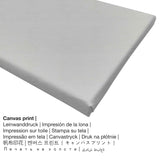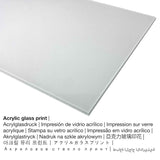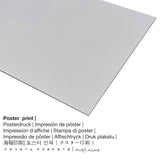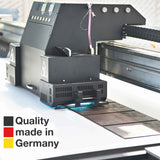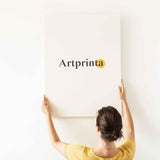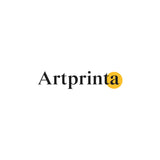Johan Braakensiek, 1920 - Nhazi maka ihe atụ na ụgbọ ala Amsterdam - ọmarịcha nka.
Ụtụ gụnyere. Mbupu gbakọrọ na ndenye ọpụpụ.
Nhọrọ ihe enwere ike
Maka ngwaahịa ọ bụla anyị na-enye ụdị nha na ihe dị iche iche. Anyị na-ahapụ gị ka ịhọrọ n'ime ụdị ndị a:
- Mpempe akwụkwọ ederede (akwa akwa akwa): The poster print is a printed canvas paper with a slightly roughened texture on the surface. It is particularly designed for putting your art print with a personal frame. Please note, that depending on the size of the poster we add a white margin of around 2-6 cm round about the work of art in order to facilitate the framing with a custom frame.
- Kwaaji: A canvas direct print is a printed canvas mounted on a wood frame. Your canvas of this artpiece will allow you to transform your new fine art print into a large work of art as you would see in a gallery. Canvas Prints have the advantage of being low in weight, which means that it is easy and straightforward to hang up the Canvas print without any wall-mounts. Canvas prints are suitable for any type of wall in your house.
- Mbipụta ọla (aluminium dibbond): These are metal prints on aluminium dibond with a true depth - for a modern impression and non-reflective surface. The Direct Print on Aluminum Dibond is the best start to art replicas on aluminum. The bright & white parts of the artpiece shimmer with a silky gloss but without the glare. The colors are luminous in the highest definition, fine details appear crisp, and you can perceive a matte appearance of the product. The direct print on aluminium is one of the most popular entry-level products and is a modern way to showcase art reproductions, because it puts the viewer’s focus on the replica of the artwork.
- Mbipụta enyo acrylic: An acrylic glass print, which is often referred to as a plexiglass print, will change your favorite original artwork into wonderful décor. Your favorite work of art is made with the help of state-of-the-art UV direct print machines. This creates sharp and rich color hues. With a glossy acrylic glass fine art print contrasts as well as details will be visible with the help of the very subtle gradation in the picture. Our plexiglass protects your custom art replica against light and heat for between 4 and 6 decades.
Nkwupụta iwu: We try whatever we can in order to describe our art products as exact as possible and to demonstrate them visually in our shop. Nonetheless, the tone of the print products, as well as the imprint may differ somehwat from the representation on your device's monitor. Depending on your settings of your screen and the condition of the surface, color pigments can unfortunately not be printed one hundret percent realistically. Given that all our art prints are printed and processed manually, there may as well be slight differences in the size and exact position of the motif.
Ozi nka nka izizi sitere na webụsaịtị ihe ngosi nka (© Copyright - Rijksmuseum - Rijksmuseum)
Design for illustration in The Amsterdam: crowds for Gem. Warehouse to include a department infants' (26 June 1920). Design for print.
Nkọwapụta ngwaahịa ebipụta
In 1920 na nwoke painter Johan Braakensiek painted the piece of art. Today, this artpiece is included in the digital collection of Rijksmuseum. Site n'ikike nke: Rijksmuseum (ikikere: ngalaba ọha).Ebe E Si Nweta nke ihe osise:. Nhazi ahụ dị na odida obodo format na a akụkụ ruru nke 2: 1, nke pụtara na ogologo ya dị okpukpu abụọ karịa obosara.
Iberibe ozi nka
| Akụkụ nka: | "Design for illustration in the Amsterdam droves" |
| Nhazi nka nka: | sere |
| Okwu mkpokọta: | nkà nke oge a |
| Time: | 20th narị afọ |
| Afọ okike: | 1920 |
| Afọ nka: | karịa afọ 100 |
| Ụlọ ihe ngosi nka / ebe: | Rijksmuseum |
| Ebe ngosi nka: | Amsterdam, Netherlands |
| Dị n'okpuru: | Rijksmuseum |
| Ụdị nka nka: | ngalaba ọha |
| Site n'aka: | Rijksmuseum |
Nkọwapụta ngwaahịa
| Nkewa edemede: | mmepụta nka |
| Usoro mmeghari: | mmeputakwa n'ụdị dijitalụ |
| Produzọ mmepụta: | UV kpọmkwem obibi |
| Nlụpụta: | arụpụtara na Germany |
| Ụdị ngwaahịa: | na mmepụta ihe |
| A na-atụ aro iji ngwaahịa eme ihe: | ụlọ mmepụta ihe nka, gallery mgbidi |
| Ndepụta: | usoro odida obodo |
| Oke akụkụ onyonyo: | 2: 1 (ogologo: obosara) |
| Nkọwa: | ogologo ahụ dị okpukpu abụọ karịa obosara |
| Nhọrọ akụrụngwa: | ígwè obibi akwụkwọ (aluminium dibond), akwụkwọ mmado (akwụkwọ kwaaji), mbipụta enyo acrylic (nke nwere ezigbo mkpuchi iko), mbipụta akwụkwọ. |
| Nhọrọ nha nke akwa akwa n'elu etiti ihe na-agbatị (mbipụta kwaaji): | 40x20cm - 16x8", 60x30cm - 24x12", 80x40cm - 31x16", 100x50cm - 39x20", 120x60cm - 47x24" |
| Mbipụta iko acrylic (nwere ezigbo mkpuchi iko) dị iche iche: | 40x20cm - 16x8", 60x30cm - 24x12", 80x40cm - 31x16", 100x50cm - 39x20", 120x60cm - 47x24" |
| Mpempe akwụkwọ mmado (akwụkwọ kwaaji) nha: | 60x30cm - 24x12", 80x40cm - 31x16", 100x50cm - 39x20", 120x60cm - 47x24" |
| Nha aluminom dibond (ihe aluminom) nha: | 40x20cm - 16x8", 60x30cm - 24x12", 80x40cm - 31x16", 100x50cm - 39x20", 120x60cm - 47x24" |
| Nhazi mmeputa nka nka: | agunyeghi |
Ozi omenka
| Ihe nkiri: | Johan Braakensiek |
| Gender: | nwoke |
| Ọrụ: | onye na-ese ihe |
| Nhazi nke onye nka: | omenkà nke oge a |
Enwere ikike nwebiisinka © - www.artprinta.com (Artprinta)


